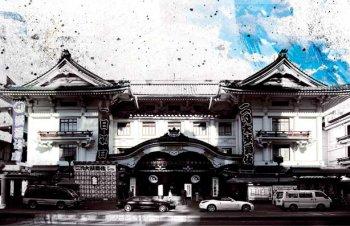Urban Developments -- Scrap and Build
 By Brett Bull
By Brett Bull
With increasing numbers of cultural properties being demolished, what has become the value of preservation?
Over the last century, earthquakes and bombing raids left the Tokyo cityscape with few long-lasting structures of architectural merit. But nowadays the elimination of such properties is increasingly becoming self-inflicted.
In October, fans of kabuki and historic architecture were saddened by entertainment company Shochiku’s announcement that it plans to demolish the landmark Kabuki-za Theater. Reconstructed twice, the theater, in Chuo ward, has been Japan’s premier home for kabuki since it was founded in 1889.
 One of Tokyo’s most culturally historic buildings, Kabuki-za in Ginza, is due to be demolished, despite protests.
One of Tokyo’s most culturally historic buildings, Kabuki-za in Ginza, is due to be demolished, despite protests.
The current five-decade-old building, which achieved tangible cultural property status in 2002, will close in 2010 and be rebuilt inside a large office-theater complex by 2013. “At present, the Kabuki-za is an aging structure that is susceptible to earthquakes,” explained Shochiku in an email statement, concerning the timing of the decision. “As well, taking into consideration that its facilities are not barrier-free, we decided that it would be in the best interest of our customers for us to rebuild the theater.”
Not to be overlooked, too, is the extraction of value Shochiku will obtain from its existing real estate asset—yet one more example of rising land prices trumping cultural worth. A February market report by brokerage house CLSA titled “Googling value: Uncovering Japan’s latent land assets” cited double-digit percentage increases in commercial land values in Tokyo’s Shibuya, Minato, and Chuo wards between 2006 and 2007. The report then noted: “This development casts a spotlight on some less-obvious beneficiaries whose main business is often not related to real estate but who nevertheless possess large and valuable landholdings.”
In a market now enduring the post-subprime meltdown, the picture is not quite as rosy. However, the suggestion remains: A sparkling, multi-use office building might serve as a better investment than an aging theater with poor structural integrity.
Similar projects are in the works. In Tokyo’s red-light district of Kabukicho, the Koma Stadium theater, the home of enka and musical performances since 1956, was this year acquired by film studio Toho, which also owns the neighboring Shinjuku Toho Kaikan. It is expected that Toho will develop both sites into one large complex following the closure of Koma this month.
Japan Post, privatized last year, announced that it will build a 200-meter building on the site of the Tokyo Central Post Office in Marunouchi, an area that has been overrun by new office towers during the last five years. Completed in 1931, the slightly curved, glazed-brick building has been selected as one of the 20 buildings that best represent modern architecture in Japan by the Paris-based conservation group Docomomo International. An architectural group has been pushing for its preservation or, at a minimum, that the building’s outer walls be incorporated into the new development.
But if recent history is any indication, the post office is on borrowed time. Publisher Kodansha’s Noma Dojo training facility, established in 1925, was knocked down late last year in favor of a more modern complex. The nearly eight-decade-old Dojunkai Aoyama Apartments were replaced in 2006 by Tadao Ando’s concrete and glass Omotesando Hills shopping center.
Posing a challenge to preservation groups is that, even if a structure has achieved tangible cultural property status under the Law for the Protection of Cultural Property, Article 29, it still allows for the annulment of this designation by the government if the cultural value is lost or there is another “special reason.”
Experts see this trend towards demolition as not an aberration but the movement of the future. Martin van der Linden, president of Tokyo-based van der Architects, believes that architecture is becoming a commodity to be viewed by its return on investment. “Everything is economically driven,” he says. “If a building doesn’t perform, it’s gone. But it is not just Japan—it is occurring all around the world.”
Brett Bull is the editor-in-chief of the online magazine The Tokyo Reporter. www.tokyoreporter.com. He can be reached at captain@bigempire.com





